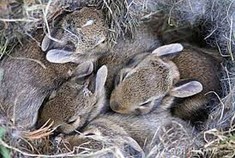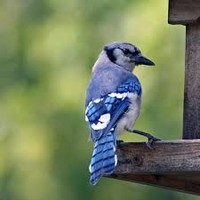Bunnies in the Backyard
By: Tom Hibbs, Naturalist
We've all seen the Eastern Cottontail, Sylvilagus Floridanus. But until I discovered a nest under my children's play house, I figured there were still some discoveries to make. While mowing the
lawn one day I noticed a familiar patch of gray fur at the edge of the play house. Assuming this was a Cottontail nest, I was hesitant to investigate any further because, as the saying goes, "the
mother may not return if it smells human scent". The fur was literally moving and my curiosity peaked. I gently lifted the fur with a stick and was surprised to see 6 young Cottontails, each about 5
inches long. Eyes closed and ears tucked back, they were poised to enjoy the warm nest for only a short time. I was excited to let the kids know what I had found. Being curious, I did a little more
research to be sure the information I had was correct. One of the most important aspects of the Cottontail's behavior is that they are crepuscular, or most active around dawn and dusk. These are also
the times the
mother is likely to feed the young at the nest. A popular misconception is that a nest has been abandoned because the mother will not be on the nest during the day.
She is usually hiding nearby to detect threats to the nest. After returning to the nest to feed the young, she will cover the young with a fresh coat of fur and a coating of grass and/or twigs;
effectively hiding them in plain sight. Perhaps one of the best reasons for the age old belief that the mother will not return if disturbed by humans is that being disturbed is quite stressful
to young Cottontails. Also, by attempting to care for the young believed to be abandoned increases their mortality by at least 90%. If you encounter a nest that has been disturbed, gently scoop up
the young and place them in or near the nest and cover them with as much of the nesting material you can find. The maternal instincts of the Cottontail are very strong and she will likely return for
the next feeding and rearrange the nest to her liking. As for our temporary tenants, the kids and some of their friends got a kick out of watching the pile of fur move about. They probably hoped that
we would have a family of rabbits wandering around the yard for a while. I would have agreed. Just two days later, the young left the nest to find their own way. The only sign of the Cottontails is a
pile of fur in the play house, which I will leave for just a while to remind us of our experience.
Follow this link for more information on the Eastern Cottontail: http://animaldiversity.ummz.umich.edu/accounts/Sylvilagus_floridanus/
Feeding Backyard Birds
By: Tom Hibbs
A great way to develop an appreciation for wildlife is to set up a backyard feeding area for birds. Autumn is the best time to make preparations for this increasingly
popular hobby for all ages. Installing a bird feeder, fruit bearing shrubs, or a combination of both provide backyard birders with frequent, year-round visitors. However, a simple bird feeder can
attract many local species that you will regularly enjoy as well!
Here are several popular feeders that you may find helpful.
Hopper Feeders are designed to hold large quantities of various seed varieties. Seed is filled into the top and spills into a pan at the bottom. A cheaper, millet-based seed mix is best for a hopper since larger quantities are used. Hoppers are popular for most local species including ground feeders like Cardinals, Mouring Doves, Sparrows, and Juncos.
Tube Feeders are a great way to give smaller feeder birds some privacy from the above mentioned ground feeders. Tubes have 2 to as many as 12 or more feeding
ports. Larger ports are best for large seeds like sunflower and safflower.
Chickadees, Tufted Titmouse, Nuthatches, and an occasional Woodpecker
enjoy tube feeders. Smaller ports are for thistle, which specifically attracts Goldfinches, Pine Siskins, and others with small bills.
Suet Feeders are typically constructed of steel mesh to enclose a suet block and allow birds to cling to it while feeding. Suet is a mash of fat byproducts and seed mixtures. Woodpeckers and
Nuthatches are common visitors to suet blocks.
Try a window feeder for kids! Very inexpensive and worth cleaning up the mess when I see how much my kids enjoy seeing birds like Chickadees and Male Cardinals up close.There are two very important
questions to keep in mind when preparing your feeding area. By far the most important is to answer this question: "How do I outsmart the squirrels?" Find a location at least 8' away from anything a
squirrel may jump from and incorporate a baffling device into your feeding area. Locate "can
style" baffles at least 4' off the ground on a pole mounted feeder and 2' from the feeder itself. "Flat style" baffles should be located on a cable feeder system at least 3' away from the end
feeders. Cables should be at least 6' off the ground.
The second question is: "How do I keep the feeders/area clean?" It is recommended that you clean your feeders at least every two weeks if you feed the birds in the summer and at least once a month
in the winter. Clean feeders and feeding areas not only create more attractive habitat, but will also help prevent the spread of avian
diseases. You will need a large bottle brush (available at pet and bird stores), an old toothbrush, and a 5 gallon bucket. A one part bleach to nine parts hot water solution works best for removable
feeders. Hopper feeders should be sprayed off completely and washed with soap and warm water. All feeders should be thoroughly rinsed and
dried before refilling with seed. Clean up spent seeds on the ground as needed.
Following these tips should help you get prepared for the busy winter feeding season. Now it's time to sit back with your binoculars and field guide and enjoy some backyard
birding!
Also, stay tuned for more information on The Great Backyard Bird Count held next year on February 14-17, 2014. The Friends of Tamanend Park will lead a team of counters, but you can conduct your
own count from your window as well!
For more backyard feeding tips and information see: http://www.birdfeeding.org/
For information on the Great Backyard Bird Count see: www.birdsource.org/gbbc/



